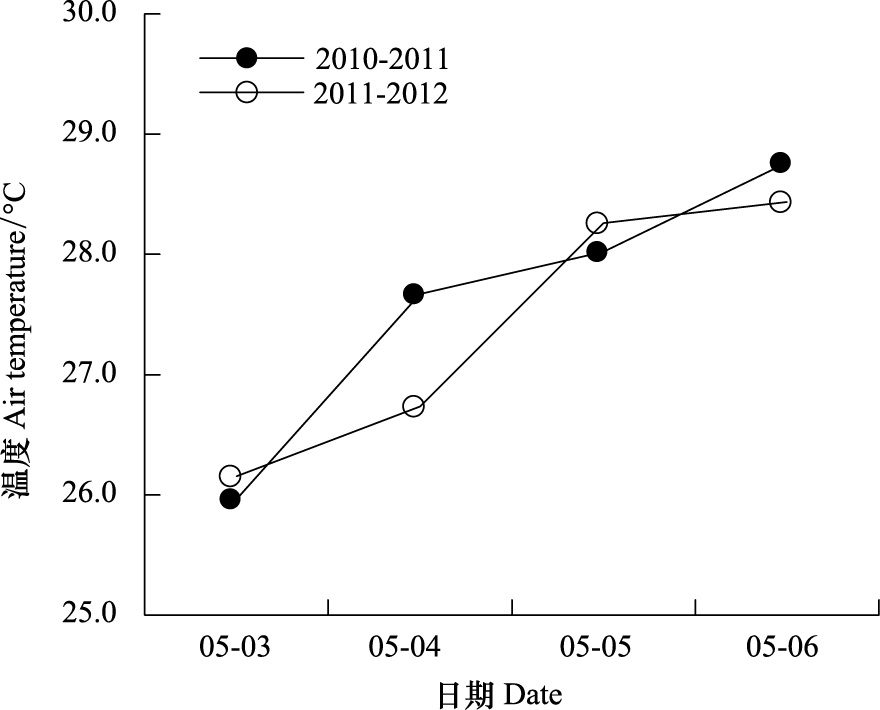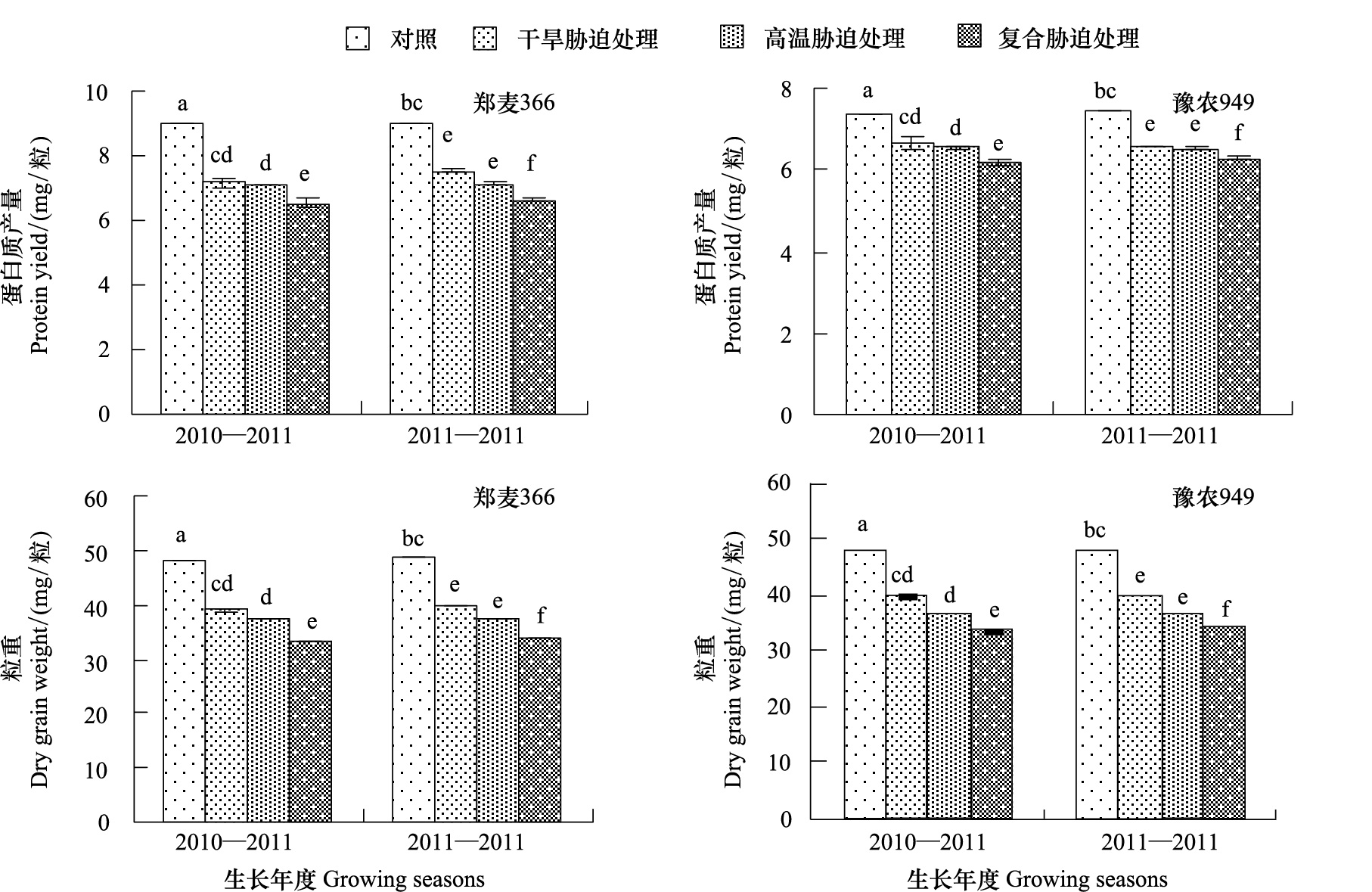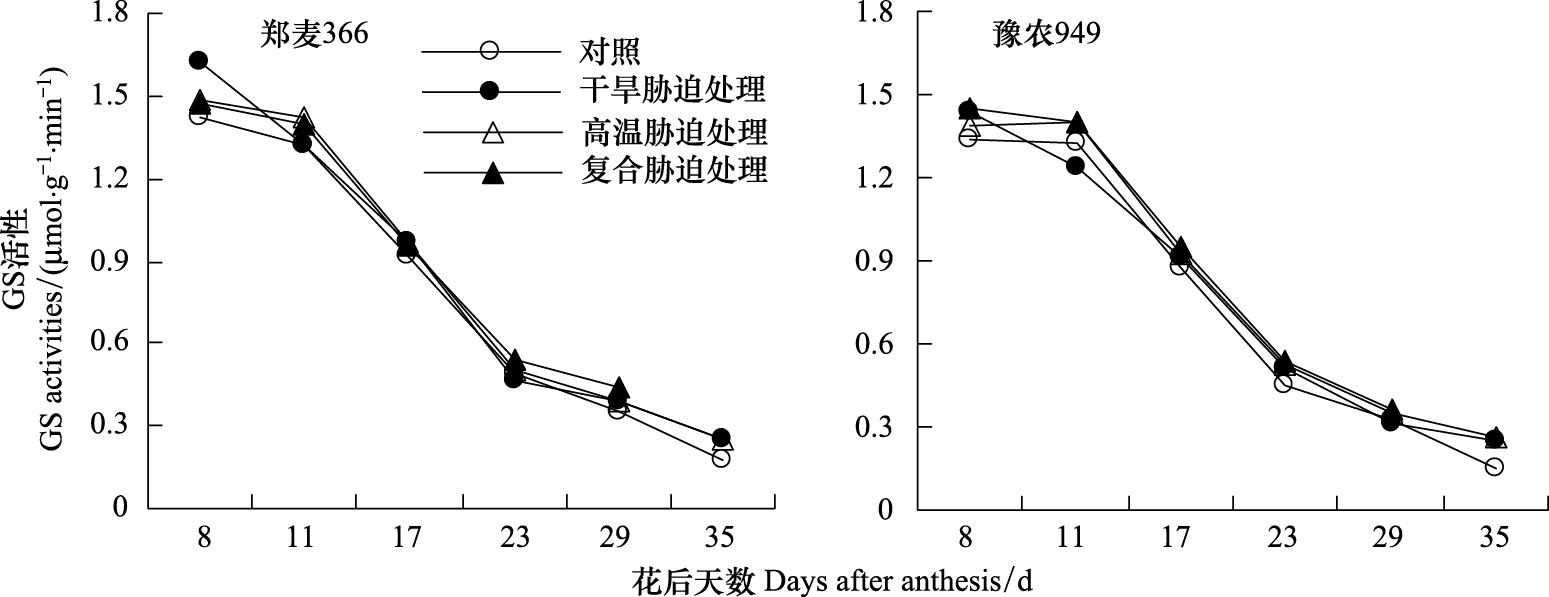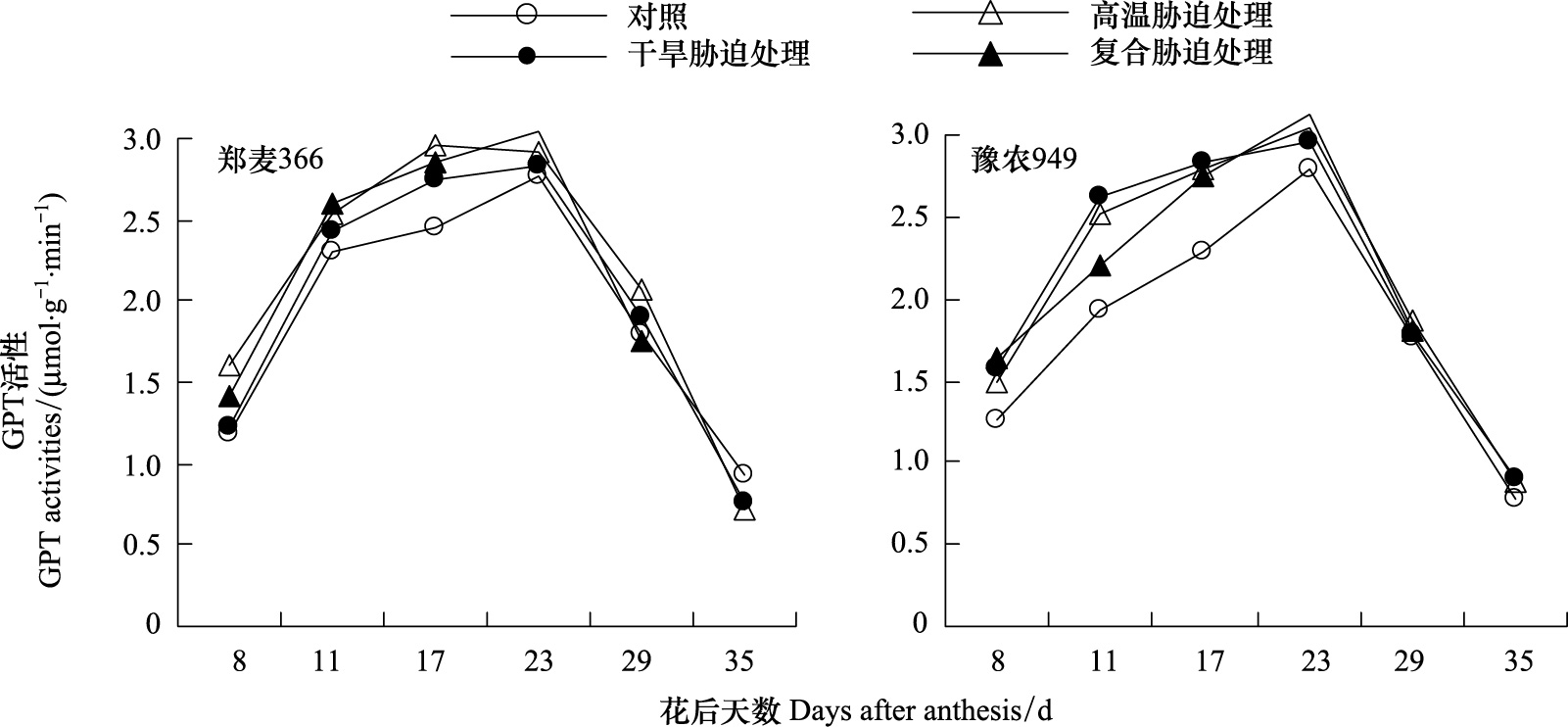文章信息
- 卢红芳, 王晨阳, 郭天财, 尹云星
- LU Hongfang, WANG Chenyang, GUO Tiancai, YIN Yunxing
- 灌浆前期高温和干旱胁迫对小麦籽粒蛋白质含量和氮代谢关键酶活性的影响
- Effects of high-temperature and drought stress on protein concentration and key enzyme activities in relation to nitrogen metabolism in wheat grains during the early stage of grain filling
- 生态学报, 2014, 34(13): 3612-3619
- Acta Ecologica Sinica, 2014, 34(13): 3612-3619
- http://dx.doi.org/10.5846/stxb201211221654
-
文章历史
- 收稿日期:2012-1-22
- 修订日期:2014-3-19
2. 国家小麦工程技术研究中心, 郑州 450002
2. National Engineering Research Center for Wheat, Zhengzhou, Henan 450002, China
蛋白质含量是决定小麦品质的重要指标之一。除了受小麦遗传特性控制外,还受温度和水分等环境条件的调控和影响[1]。研究表明,土壤干旱和渍水会提高小麦籽粒中蛋白质含量,但降低蛋白质产量,影响籽粒品质[2, 3, 4]。35 ℃以上短暂高温可以提高籽粒蛋白质含量,但会降低面团强度[5]。蛋白质生物合成过程是在一系列酶的催化协同作用下共同完成的,最终决定蛋白质品质。其中,谷氨酰胺合成酶(glutamine synthetase,GS)和谷丙转氨酶(glutamic pyruvic transaminase,GPT)是调控小麦籽粒蛋白质形成的两个关键酶[6]。GS是处于氮代谢中心的多功能酶,参与多种氮代谢调节,对氨基酸初步合成及氮的再同化有重要作用[6, 7, 8]。GPT是一种重要的转氨酶,调控N从其主要载体谷氨酸向组成蛋白质的其它氨基酸转移,是催化生成丙氨酸的关键酶[6]。GS和GPT活性显著受温度和水分等外界条件的影响。研究表明,土壤渍水和干旱导致小麦旗叶GS活性和籽粒GPT活性降低,籽粒蛋白质产量下降,品质变劣[4]。但也有研究发现干旱提高小麦籽粒GPT活性,促进籽粒蛋白质形成[9]。
小麦灌浆期是植株生长发育最易受不良环境条件影响的时期。在黄淮广大麦区,小麦灌浆期常出现38 ℃的极端高温天气[10],且高温常与干旱相伴发生,或形成典型的干热风,造成小麦减产10%—20%[11],并严重影响籽粒品质形成。以往结合高温、干旱单一胁迫的研究多集中在植株叶片GS、GPT活性等方面,围绕籽粒氮代谢关键酶及蛋白质合成酶学机制的研究相对较少,更缺乏复合胁迫影响的研究。基于此,本文采用盆栽与典型模拟相结合的方式,研究了花后高温、干旱及其复合胁迫对小麦籽粒GS、GPT活性及蛋白质组分的影响,以期为抗逆高产栽培及品质调优提供理论依据。
1 材料与方法 1.1 试验设计盆栽试验于2010—2012年在河南农业大学郑州科教示范园区采用完全随机设计进行。选用强筋小麦品种郑麦366(根据近红外谷物分析仪对2009—2010年度试验点大田试验测定结果,蛋白质含量16.4%,湿面筋含量32.9%)和中筋小麦品种豫农949(蛋白质含量15.4%,湿面筋含量29.7%)作为试验材料。盆栽用土取自大田0—20 cm耕层,土壤有机质含量18 g/kg,碱解氮 57 mg/kg,速效磷 67 mg/kg,速效钾 204 mg/kg。试验用盆采用底部带小孔的塑料盆钵,盆高27 cm、盆口直径24 cm,每盆装土10 kg。10月18日播种,播种前N、P、K施用量分别按每盆施1.1 g N,1.3 g P2O5 and 1.1 g K2O作基肥(拔节期结合浇水按每盆1.1 g 追施N肥),每盆定苗12株。开花期选取长势均匀一致的麦穗进行标记供取样。
高温处理采用人工气候室模拟方式进行。于花后7 d将长势均匀一致的供试盆栽转移至人工气候室。用100 W高压钠灯模拟自然光,光照强度约1400 μE/m2。以38 ℃高温处理4 d,处理时间为每天11:00—16:00,共5 h。每天处理结束后,把盆栽转移至大田环境条件下。所有处理结束后,全部处理均移至大田环境条件下生长至成熟。干旱及复合胁迫处理自高温处理前一周左右开始控制浇水,遮棚排除自然降水影响,采用称重法和TDR300(水分测定仪)相结合的方法测定盆栽土壤含水量,确保高温处理时达到目标含水量(轻度干旱,土壤相对含水量为50%)。以田间正常温度和正常供水条件下生长的小麦为对照(CK,土壤相对含水量为75%左右)。图 1为2010—2012生育期内高温处理期间大田生长环境的平均温度(x1=27.6 ℃,2010—2011;x2=27.4 ℃,2011—2012)。

|
| 图 1 2010—2011和2011—2012年度高温处理期间大田环境正常温度 Fig. 1 Air temperature of field environment for the periods of the high temperature applied during the 2010—2011 and 2011—2012 growing seasons |
于开花期选择同一天开花、生长均匀一致的麦穗挂牌标记。高温处理前和结束后分别取样,之后每隔6 d取样至成熟。每次取样的新鲜籽粒一部分在液氮中速冻并保存在-40 ℃冰箱中,供测定GS和GPT酶活性,一部分烘干供测定蛋白质及其组分含量。
称取新鲜籽粒0.5 g,加5 mL Tris-HCl缓冲提取液(含1 mmol/L MgCl2、1 mmol/L EDTA和2 mmol/L DTT,pH值=7.6)研磨成匀浆,匀浆液于13000 r/min离心25 min,取上清液,用于GS活性测定。测定方法参照《植物生理学实验指导》[12]。GPT活性测定参照吴良欢等[13]的方法。蛋白质及其组分含量测定采用全自动凯氏定氮法。蛋白质含量与全氮含量之间的换算系数为5.7。
1.3 数据分析用SPSS(Statistical Package for the Social Science) 软件对试验数据进行方差分析、相关分析和显著性测验。
2 结果与分析 2.1 高温、干旱及其复合胁迫对小麦籽粒蛋白质含量及其组分的影响从表 1可以看出,高温处理显著提高了两品种小麦籽粒总蛋白质含量及清蛋白、球蛋白和醇溶蛋白含量,但对谷蛋白含量影响相对较小,使谷/醇比显著下降;两品种比较,高温处理对郑麦366的影响大于豫农949。干旱胁迫显著提高了两品种籽粒醇溶蛋白含量,但对清蛋白、球蛋白和谷蛋白的影响均较小,导致谷/醇比降低;豫农949籽粒总蛋白质含量在干旱胁迫下显著升高(两年结果一致),而郑麦366在2010—2011年度下降,2011—2012年度显著升高。从表 1还可以看出,高温处理对籽粒蛋白质合成的影响大于干旱胁迫。复合胁迫显著提高了籽粒总蛋白质含量、清蛋白和球蛋白含量,但显著降低了谷蛋白含量(两品种表现一致),但对醇溶蛋白含量的影响在品种间存在差异:复合胁迫显著提高了郑麦366醇溶蛋白含量,使谷/醇比显著下降,但对豫农949醇溶蛋白含量影响较小。
|
品种
Cultivar | 年份
Growing seasons | 处理
Treatments | 总蛋白质含量
Total Protein concentration/% | 清蛋白
Albumin/% | 球蛋白
Globulin/% | 醇溶蛋白
Gliadin/% | 谷蛋白
Glutenin/% | 谷/醇比
Glu/Gli |
| CK: 对照 Control,WD:干旱胁迫处理 Drought-stressed treatment,HT:高温胁迫处理Heat-stressed treatment,HT×WD:复合胁迫处理 Combination-stressed treatment;每栏中数据后不同字母表示0.05水平显著性差异 | ||||||||
| 郑麦366 | 2010—2011 | CK | 18.67c | 2.58hi | 1.15f | 5.78fg | 6.70b | 1.16a |
| WD | 18.47c | 2.57hi | 1.32cd | 6.77a | 6.60c | 0.97d | ||
| HT | 19.07b | 3.11ab | 1.55b | 6.78a | 6.87a | 1.01c | ||
| HT×WD | 19.57a | 3.09b | 1.92a | 6.05e | 5.87de | 0.97d | ||
| 2011—2012 | CK | 18.47c | 2.53i | 1.30cde | 5.84f | 6.68b | 1.14a | |
| WD | 18.87b | 2.54i | 1.34c | 6.79a | 6.56c | 0.97d | ||
| HT | 19.07b | 2.99c | 1.52b | 6.45bc | 6.86a | 1.06b | ||
| HT×WD | 19.47a | 2.94d | 1.62b | 6.01e | 5.90d | 0.98d | ||
| 豫农949 | 2010—2011 | CK | 15.47h | 2.64g | 1.20ef | 5.71g | 5.82efg | 1.02c |
| WD | 16.87e | 2.63gh | 1.21def | 6.44bc | 5.72hi | 0.89fg | ||
| HT | 18.07d | 3.15a | 1.56b | 6.54b | 5.79fg | 0.89fg | ||
| HT×WD | 18.47c | 2.84e | 1.97a | 5.85f | 5.08j | 0.89g | ||
| 2011—2012 | CK | 15.67g | 2.71f | 1.22def | 5.83fg | 5.76gh | 0.99d | |
| WD | 16.47f | 2.61gh | 1.23def | 6.29d | 5.67i | 0.90ef | ||
| HT | 18.07d | 3.03bc | 1.59b | 6.38cd | 5.85def | 0.92e | ||
| HT×WD | 18.57c | 2.80e | 1.94a | 5.81fg | 5.04j | 0.87g | ||
图 2所示,高温处理使郑麦366、豫农949籽粒 蛋白质产量分别下降20.9%(2010—2011)、20.7%(2011—2012)和11.3%(2010—2011)、12.4%(2011—2012);粒重分别下降22.5%、23.2%和24.1%、24.0%。干旱胁迫下,郑麦366、豫农949籽粒蛋白质产量分别下降19.7%(2010—2011)、16.2%(2011—2012)和9.4%(2010—2011)、11.9%(2011—2012);粒重分别下降18.8%、18.0%和16.9%、16.0%。复合胁迫使郑麦366、豫农949籽粒蛋白质产量分别下降27.0%(2010—2011)、26.1%(2011—2012)和16.2%(2010—2011)、15.8%(2010—2011);粒重分别下降30.3%、29.9%和29.8%、28.9%。可见,2a试验结果基本一致。在试验条件下,高温处理的影响大于干旱胁迫,复合胁迫具有明显的叠加效应。两品种比较,强筋小麦郑麦366受逆境胁迫的影响较大。

|
| 图 2 高温、干旱及其互作对小麦蛋白质产量和粒重的影响 Fig. 2 Effects of heat,drought and its combination on the yield of wheat grain protein and dry grain weight 不同字母表示0.05水平显著性差异 |
随小麦灌浆进程的推进,两品种籽粒GS活性均呈逐渐下降趋势(图 3)。与对照比较,高温胁迫使灌浆期两品种籽粒GS活性平均分别提高12.0%和16.2%,复合胁迫下两品种GS活性分别提高10.8%和14.7%。干旱胁迫则使花后11 d和23 d的GS活性有不同程度下降,其它时期升高。复合胁迫加快了两品种籽粒灌浆进程,使灌浆持续期缩短6 d。从对籽粒GS活性的影响看,高温与干旱胁迫具有叠加效应。两品种比较,豫农949籽粒GS活性对逆境胁迫更为敏感(图 3)。

|
| 图 3 花后小麦籽粒GS活性的积累动态 (2011—2012) Fig. 3 Dynamic changes of GS activities in wheat grains after anthesis |
小麦籽粒GPT活性先上升,于花后23 d达最大值,之后迅速下降(图 4)。花后8—23 d,高温、干旱及复合胁迫明显提高了籽粒GPT活性,之后影响迅速减小,使不同处理间籽粒GPT活性差异不大。高温处理显著提高了郑麦366花后8,17和23 d籽粒GPT活性和豫农949花后11,17和23 d GPT活性)。干旱胁迫显著提高了郑麦366花后17 d籽粒GPT活性和豫农949花后11和17 d GPT活性。复合胁迫使郑麦366花后8,17和23 d籽粒GPT活性显著升高,豫农949花后17和23 d籽粒GPT活性显著升高。花后29 d,单一胁迫使两品种籽粒GPT活性不同程度升高,而复合胁迫对两品种的影响存在差异:郑麦366籽粒GPT活性下降,而豫农949籽粒GPT活性升高。花后35 d,高温和干旱胁迫均使郑麦366籽粒GPT活性下降,而使豫农949籽粒GPT活性升高。

|
| 图 4 花后小麦籽粒GPT活性的积累动态 (2011—2012) Fig. 4 Dynamic changes of GPT activities in wheat grains after anthesis |
表 2所示,不同时期籽粒GS活性与蛋白质含量、蛋白质产量和粒重的相关性存在有差异:花后8,17,23和29 d籽粒GS活性与蛋白质含量呈显著或极显著正相关;花后8,17,23,29 和35 d籽粒GS活性与籽粒产量呈显著或极显著负相关;花后23和35 d 籽粒GS活性与籽粒蛋白质产量呈极显著负相关。从表 3可以看出,花后11和17 d籽粒GPT活性与籽粒蛋白质含量呈极显著正相关;花后8、17和23 d籽粒GPT活性与籽粒蛋白质产量呈极显著负相关;花后8、11、17和23 d籽粒GPT活性与籽粒产量呈显著或极显著负相关。可见,籽粒GPT主要在灌浆前期起作用。
| 花后天数 Days after anthesis/d | |||||||
| 8 | 11 | 17 | 23 | 29 | 35 | ||
| 表 中*表示在0.05水平相关,**表示0.01水平相关 | |||||||
| 2010—2011 | 蛋白质含量
Total protein concentration/% | 0.730* * | 0.139 | 0.703* * | 0.458* | 0.706* * | 0.464 |
| 蛋白质产量
Protein yield/(mg/粒) | -0.100 | -0.216 | -0.220 | -0.542* * | -0.144 | -0.648* * | |
| 籽粒产量
Grain yield/(mg/粒) | -0.479* | -0.251 | -0.567* * | -0.716* * | -0.478* | -0.914* * | |
| 2011—2012 | 蛋白质含量
Total protein concentration/% | 0.746* * | 0.159 | 0.720* * | 0.413* | 0.706* * | 0.414 |
| 蛋白质产量
Protein yield/(mg/粒) | -0.066 | -0.141 | -0.159 | -0.536* * | -0.082 | -0.649* * | |
| 籽粒产量
Grain yield/(mg/粒) | -0.464* | -0.203 | -0.532* * | -0.698* * | -0.436* | -0.905* * | |
| 花后天数 Days after anthesis/d | |||||||
| 8 | 11 | 17 | 23 | 29 | 35 | ||
| 表 中*表示在0.05水平相关,**表示0.01水平相关 | |||||||
| 2010—2011 | 蛋白质含量
Total protein concentration/% | 0.065 | 0.519* * | 0.554* * | 0.208 | 0.103 | 0.009 |
| 蛋白质产量
Protein yield/(mg/粒) | -0.527* * | -0.256 | -0.554* * | -0.710* * | 0.003 | 0.262 | |
| 籽粒产量
Grain yield/(mg/粒) | -0.486* | -0.516* * | -0.777* * | -0.709* * | -0.069 | 0.198 | |
| 2011—2012 | 蛋白质含量
Total protein concentration/% | 0.111 | 0.469* | 0.567* * | 0.184 | 0.163 | -0.134 |
| 蛋白质产量
Protein yield/(mg/粒) | -0.487* | -0.282 | -0.499* | -0.713* * | 0.146 | 0.122 | |
| 籽粒产量
Grain yield/(mg/粒) | -0.487* | -0.518* * | -0.750* * | -0.714* * | 0.021 | 0.161 | |
温度和水分是影响作物生长发育的关键生态因子,在很大程度上影响籽粒灌浆进程及籽粒品质、产量形成。有研究表明,高温降低叶光合同化效率,使叶片光合产物输出紊乱,抑制籽粒中光合产物的累积[14]。尽管高温在短时间内提高籽粒胚乳细胞分裂速率,但由于分裂期明显缩短,最终胚乳细胞数减少,粒重显著降低[15]。灌浆期间高温或干旱胁迫对蛋白质积累产生负面影响,使蛋白质产量下降[2, 3, 4, 16]。本试验条件下,高温(38 ℃)分别降低了籽粒蛋白质产量20.7%—20.9%(郑麦366)和11.3%—12.4%(豫农949),干旱降低16.2%—19.7%(郑麦366)和9.4%—11.9%(豫农949),复合胁迫降低26.1%—27.0%(郑麦366)和15.8%—16.2%(豫农949)。表明高温处理的影响大于干旱胁迫,两者具有显著的叠加效应。两品种比较,强筋小麦品种郑麦366受逆境胁迫的影响较大。
3.2 高温、干旱及其复合胁迫对籽粒蛋白质含量、组分的影响籽粒蛋白质含量易受温度等环境影响,灌浆期温度升高往往使籽粒蛋白质含量提高[16],但含量相对高是籽粒淀粉合成受抑较大的缘故[17];不同品种对高温胁迫的敏感性存在显著差异[14, 15, 16, 17, 18]。本研究结果表明,高温、干旱及其复合胁迫均显著提高籽粒蛋白质含量,其中中筋小麦品种豫农949受影响较大;单一因子比较,高温胁迫的影响大于干旱胁迫。小麦籽粒蛋白组分,尤其谷/醇比在很大程度上决定了籽粒品质的优劣,高温处理显著降低了谷/醇比,从而导致面团强度、面包体积和评分等烘烤品质变劣[5, 19, 20]。本研究表明,高温处理显著提高了小麦籽粒总蛋白质含量及清蛋白、球蛋白和醇溶蛋白含量,但对谷蛋白含量的影响较小,使谷/醇比显著下降。干旱显著提高了小麦籽粒醇溶蛋白含量,但对清蛋白,球蛋白和谷蛋白的影响较小,谷/醇比亦降低。
3.3 高温干旱胁迫下籽粒GS、GPT活性变化及其与蛋白质含量的关系GS和GPT是调控小麦籽粒蛋白质合成的两个关键酶,其活性显著受环境条件的影响。有研究表明,高温和干旱均导致小麦旗叶GS活性和籽粒GPT活性降低,使蛋白质合成受抑,籽粒蛋白质产量下降[4, 20, 21]。小麦籽粒GPT活性与籽粒蛋白质产量显著正相关[20],而籽粒GS活性与蛋白质含量和产量的相关性均较小[4, 20]。也有研究认为干旱胁迫提高籽粒GPT活性,促进蛋白质的合成[9]。本研究表明,高温、干旱及其互作在一定时期均提高了小麦籽粒GS和GPT活性,其中豫农949更易受胁迫影响。不同时期小麦籽粒GS和GPT活性与籽粒蛋白质含量(正相关)及蛋白质产量(负相关)的相关性存在有差异。花后8,17,23和29 d的籽粒GS活性及花后11和17 d的籽粒GPT活性与蛋白质含量关系密切,花后23和35 d的籽粒GS活性及花后8、17和23 d的籽粒GPT活性与籽粒蛋白质产量密切相关。
综上所述,逆境胁迫下籽粒GS和GPT活性升高是导致籽粒蛋白质相对含量升高的重要原因,但不能提高粒重和蛋白质产量。籽粒GS活性对蛋白质合成都有重要影响,而籽粒GPT活性主要在生育前期起作用。蛋白质合成除受GS和GPT活性的影响外,还与其他蛋白质合成酶和淀粉合成酶有关,这方面有待深入研究。
4 结论灌浆前期高温和干旱胁迫显著提高了两品种小麦籽粒蛋白质含量,但导致谷/醇比降低,并使蛋白质产量显著下降。其中,高温使郑麦366和豫农949蛋白质产量分别下降20.7%和16.2%,干旱下降26.1%和12.4%,,复合胁迫下降1 1.9%和15.8%。同时,高温、干旱及其复合胁迫均使两品种小麦籽粒氮代谢关键酶活性升高,花后8,17,23和29 d的籽粒GS活性及花后11和17 d的籽粒GPT活性与蛋白质含量呈显著或极显著正相关;花后23和35 d的籽粒GS活性及花后8、17和23 d的籽粒GPT活性与籽粒蛋白质产量呈显著或极显著负相关。两年试验结果一致,从影响因子来看,高温胁迫对小麦蛋白质合成的影响大于干旱胁迫,复合胁迫具有明显的叠加效应。两品种比较,逆境胁迫下强筋小麦品种郑麦366蛋白质产量降幅较大,而豫农949蛋白质含量更易受影响。
| [1] | Daniel C, Triboy E. Changes in wheat protein aggregation during grain development: effects of temperatures and water stress. European Journal of Agronomy, 2002, 16(1): 1-12. |
| [2] | Zhang B J, Fan H L. Progress on the study of effects of environment conditions on wheat protein. Research of Soil and Water Conservation, 2002, 9(2): 61-63. |
| [3] | Xu Z Z, Yu Z W, Wang D, Zhang Y L. Effect of irrigation conditions on protein composition accumulation of grain and its quality in winter wheat. Acta Agronomica Sinica, 2003, 29(5): 682-687. |
| [4] | Xie Z J, Jiang D, Cao W X, Dai T B, Jing Q. Effects of post-anthesis soil water status on the activities of key regulatory enzymes of starch and protein accumulation in wheat grains. Journal of Plant Physiology and Molecular Biology, 2003, 29(4): 309-316. |
| [5] | Randall P J, Moss H J. Some effects of temperature regime during grain filling on wheat quality. Australia Journal of Agricultural Research, 1990, 41(4): 602-617. |
| [6] | Lea D J, Robinson S A, Stewart G R. The enzymology and metabolism of glutamine, glutamate, and asporagine//Miflin B J, Lea P J, eds. The Biochemistry of Plants. New York: Academic Press, 1990, 16: 121-159. |
| [7] | Chai X Q, Yin L P, Liu X L, Yu B X, Han Q E, Hong J M, Qiu Z S. Influence of different concentrations of NO3- and NH4+ on the activity of glutamine synthetase and other relevant enzymes of nitrogen metabolism in wheat roots. Acta Botanica Sinica, 1996, 38(10): 803-808. |
| [8] | Huang Q N, Yin L P, Chai X Q, Liu X L, Hong J M, Zhao W P. Influence of nitrogen sources on glutamine synthetase in wheat seeding. Acta Botanica Sinica, 1995, 37(11): 856-862. |
| [9] | Fan X M, Jiang D, Dai T B, Jing Q, Cao W X. Effects of nitrogen rates on activities of key regulatory enzymes for grain starch and protein accumulation in wheat grown under drought and waterlogging from anthesis to maturity. Scientia Agricultura Sinica, 2005, 38(6): 1132-1141. |
| [10] | Wang C Y, Guo T C, Yan Y L, Zhu Y J, Xia G J, Wang H C, Zhou J Z. Effects of short post-anthesis high temperature stress on leaf photosynthetic potential in winter wheat (Triticum aestivum L.). Acta Agronomica Sinica, 2004, 30(1): 88-91. |
| [11] | Miao J L, Wang C Y, Guo T C, Ma D Y, Hu J B, Feng H. Effects of post-anthesis interactions of high temperature and drought stresses on content and composition of grain starch in two wheat cultivars with different gluten strength. Journal of Triticeae Crops, 2008, 28(2): 254-259. |
| [12] | Zou Q. The guidance of Plant Physiology Experiments. Beijing: China Agricultural University Press, 2000. |
| [13] | Wu L H, Jiang S H, Tao Q M. The photocolorimetric method determining the transaminase (GOT and GPT) activities in plant and its application. Chinese Journal of Soil Science, 1998, 29(3): 136-138. |
| [14] | Guo W S, Shi J S, Peng Y X, Feng C N, Ge C L, Zhu X K. Effect of high temperature on transportation of assimilate from wheat flag leaf during grain filling stage. Acta Agriculturae Nucleatae Sinica, 1998, 12(1): 21-27. |
| [15] | Feng C N, Guo W S, Shi J S, Peng Y X, Zhu X K. Effect of high temperature after anthesis on endosperm cell development and grain weight in wheat. Acta Agronomica Sinica, 2000, 26(4): 399-405. |
| [16] | Sofield I, Evans L T, Cook M G, Wardlaw I F. Factors influencing the rate and duration of grain filling in wheat. Australia Journal of Plant Physiology, 1977, 4(5): 785-797. |
| [17] | Jenner C F, Ugalde T D, Aspinall D. The physiology of starch and protein deposition in the endosperm of wheat. Australia Journal of Plant Physiology, 1991, 18(3): 211-226. |
| [18] | Stone P J, Nicolas M E. Effect of timing of heat stress during grain filling on two w heat varieties differing in heat tolerance. II. Fractional protein accumulation. Australia Journal of Plant Physiology, 1996, 23(6): 739-749. |
| [19] | Stone P J, Nicolas M E. Comparison of sudden heat stress with gradual exposure to high temperature during grain filling in two wheat varieties differing in heat tolerance. II. Fractional protein accumulation. Australia Journal of Plant Physiology, 1998, 25(1): 1-11. |
| [20] | Zhao H, Jing Q, Dai T B, Jiang D, Cao W X. Effects of post-anthesis high temperature and water stress on activities of key regulatory enzymes involved in protein formation in two wheat cultivars. Acta Agronomica Sinica, 2007, 33(12): 2021-2027. |
| [21] | Liu P, Guo W S, Pu H C, Feng C N, Zhu X K, Peng Y X. Effects of transient high temperature after anthesis on grain protein content and physiological mechanism in wheat (Triticum aestivum L.). Acta Agronomica Sinica, 2007, 33(9): 1516-1522. |
| [2] | 张保军, 樊虎玲. 环境条件对小麦蛋白质的影响研究进展. 水土保持研究, 2002, 9(2): 61-63. |
| [3] | 许振柱, 于振文, 王东, 张永丽. 灌溉条件对小麦籽粒蛋白质组分积累及其品质的影响. 作物学报, 2003, 29(5): 682-687. |
| [4] | 谢祝捷, 姜东, 曹卫星, 戴廷波, 荆奇. 花后土壤水分状况对小麦籽粒淀粉和蛋白质积累关键调控酶活性的影响. 植物生理与分子生物学报, 2003, 29(4): 309-316. |
| [7] | 柴小清, 印莉萍, 刘祥林, 于宝霞, 韩秋娥, 洪剑明, 邱泽生. 不同浓度的NO3 和NH4+对小麦根谷氨酰胺合成酶及其相关酶的影响. 植物学报, 1996, 38(10): 803-808. |
| [8] | 黄勤妮, 印莉萍, 柴晓清, 刘祥林, 洪剑明, 赵微平. 不同氮源对小麦幼苗谷氨酰胺合成酶的影响. 植物学报, 1995, 37(11): 856-862. |
| [9] | 范雪梅, 姜东, 戴廷波, 荆奇, 曹卫星. 花后干旱和渍水下氮素供应对小麦籽粒蛋白质和淀粉积聚关键调控酶活性的影响. 中国农业科学, 2005, 38(6): 1132-1141. |
| [10] | 王晨阳, 郭天财, 阎耀礼, 朱云集, 夏国军, 王化岑, 周继泽. 花后短期高温胁迫对小麦叶片光合性能的影响. 作物学报, 2004, 30(1): 88-91. |
| [11] | 苗建利, 王晨阳, 郭天财, 马冬云, 胡吉帮, 冯辉. 高温与干旱互作对两种筋力小麦品种籽粒淀粉及其组分含量的影响. 麦类作物学报, 2008, 28(2): 254-259. |
| [12] | 邹奇. 植物生理学实验指导. 北京: 中国农业出版社, 2000. |
| [13] | 吴良欢, 蒋式洪, 陶勤南. 植物转氨酶(GOT和GPT)活度比色测定方法及其应用. 土壤通报, 1998, 29((3): 136-138. |
| [14] | 郭文善, 施劲松, 彭永欣, 封超年, 葛才林, 朱新开. 灌浆期高温对小麦光合产物运转的影响. 核农学报, 1998, 12(1): 21-27. |
| [15] | 封超年, 郭文善, 施劲松, 彭永欣, 朱新开. 小麦花后高温对籽粒胚乳细胞发育及粒重的影响. 作物学报, 2000, 26(4): 399-405. |
| [20] | 赵辉, 荆奇, 戴廷波, 姜东, 曹卫星. 花后高温和水分逆境对小麦籽粒蛋白质形成及其关键酶活性的影响. 作物学报, 2007, 33(12): 2021-2027. |
| [21] | 刘萍, 郭文善, 浦汉春, 封超年, 朱新开, 彭永欣. 花后短暂高温对小麦籽粒蛋白质含量的影响及其生理机制. 2007, 33(9): 1516-1522. |
 2014, Vol. 34
2014, Vol. 34




